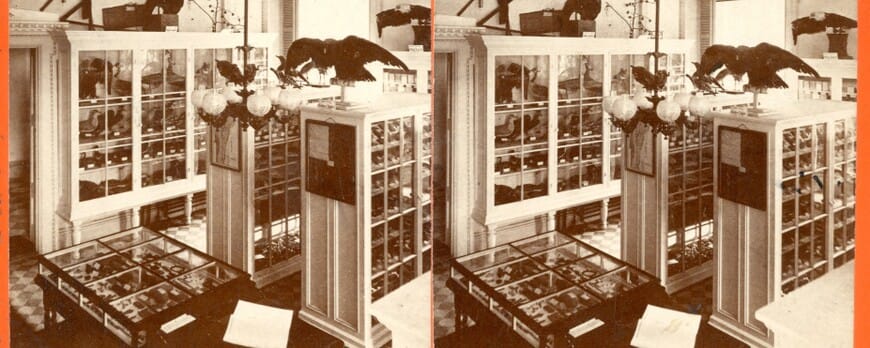Changing Collections
The new VHS Research and Exhibition Gallery shows how much the role of physical objects and museums has changed over the centuries

In October 2024, the Vermont Historical Society will formally open the Research and Exhibition Gallery in Barre’s Vermont History Center. This gallery will help to showcase a wide range of the Society’s object collections, bringing them out from the basement storage rooms and into the view of the general public. It’s a major new project that is in step with today’s museum practices: increasing accessibility of collections and objects to allow visitors and scholars to view them.
With the space to display thousands of items behind glass at once, this gallery looks similar to the cabinets loaded with items that were once the centerpiece of collectors and early museums. Indeed, many of the world’s modern museums and institutions evolved from the scientific and anthropological collections of wealthy patrons. But the Research and Exhibition Gallery is a far cry from those early cases, showing just how much the role of physical objects and museums has changed over the centuries.
The United States was undergoing a period of reflection when Vermont’s legislature chartered the Vermont Historical and Antiquarian Society in 1838. The generation that fought in the American Revolution had largely died out, and many worried that as the population of young Americans moved out west, the country would become unmoored from the foundations and principles upon which it was built. State officials and scholars worked to solve that problem by establishing historical societies and educational programs to preserve the documents and objects that helped tell the country’s story.
The legislature tasked VHS with “collecting and preserving materials for civil and natural history of the State of Vermont,” with its library and cabinet in Barnet, the home of one of the society’s founding members, Henry Stevens. Initially, the Society’s primary focus was on acquiring documents related to the founding of Vermont. In his book Up & Doing: The Vermont Historical Society, 1838-1970, former VHS director Weston A. Cate, Jr., notes that there were a few reasons for this: the concept of a museum was still young, collections of objects took up space, and there was already a “State Cabinet” located at the State House.
When a fire tore through the State House on January 6th, 1857, it destroyed not only much of the State Cabinet, but also the items from Stevens’ personal collection that he had stored there and whatever items VHS had stored in the space allotted to it by the legislature. When the building was reconstructed, it included space for a new Cabinet room to house various artifacts and relics from the state’s past.
In the decades that followed, space became a constant concern for the Society. In 1886, it and the Vermont State Library moved into a newly constructed annex behind the State House, and again in 1918 to the new Vermont Supreme Court Building down the hill. There, the Society consolidated the collection that had been stored all over the state. VHS remained there until 1960, when it once again outgrew its space and relocated to the National Life building across the campus, only to move back across in 1970 into the first floor of the reconstructed Pavilion Building.
As VHS hopped from location to location over the 19th and early 20th century, its collection grew. “No longer was the Society interested only in relics,” Cate writes. VHS “broadened its vision to include all kinds of artifacts from buttonhooks to full-sized buildings such as the Hyde Log Cabin in Grant Isle.” These physical objects brought a new dimension to the types of history and stories that the Society was able to preserve, from items from notable battles to the ephemera of everyday Vermont life.
As the collection grew, so too did the demands on VHS staff, who not only had to catalog and document the collection, but to also provide care to ensure that items would survive for future generations. Cate notes that through the middle of the 20th century, the Society’s librarians oversaw both the library and object collections, and in the years following the Second World War and into the 1960s, the Society and its staff produced numerous exhibits in the Supreme Court and National Life Buildings, writing: “they reflected the then current practice in museum presentations, which contrasts dramatically with today’s [late 1980s].” The move to the “Pavilion Building offered the first real opportunity to apply modern museum techniques. No longer were exhibits crammed solely into glass cases. Instead, visitors’ attention was focused on a series of modules in which representative exhibits traced the history of the state.”
In addition to applying new practices to preserve the collection, Cate explains that it’s the move to the Pavilion Building that best highlighted the Society’s changing mission: “from a library for the use primarily of scholars, genealogists, and historians with scant attention to a ‘cabinet’ to a greater balance between historical library research and exhibits that help interpret the past.”
In many ways, VHS’s story mirrors that of the museum itself: how disparate collections assembled by enthusiasts transformed into institutions of preservation and learning. While the focus began with books and documents, it has expanded to include photographs and objects held and used by Vermonters. This addition brings new dimensions to Vermont’s stories, bringing about a fuller picture of our past for all to learn.